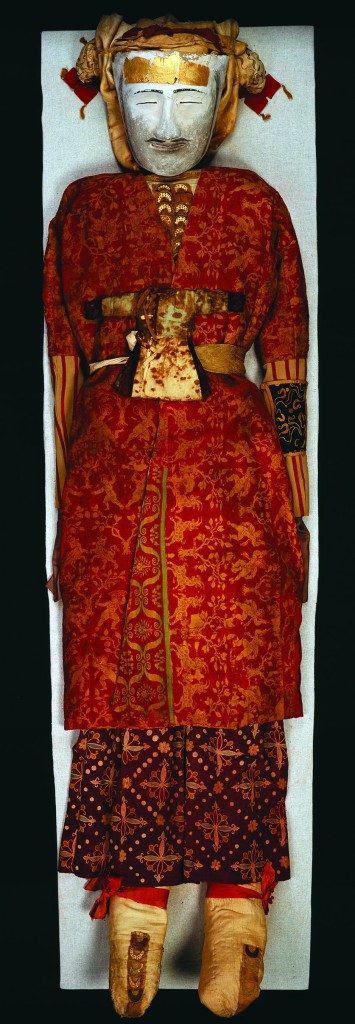Yingpan Man’s Fabulous Wealth
by Heather Pringle
March 29, 2010
 The Bowers Museum in Santa Ana, California, has been grabbing headlines over the past week for a much anticipated exhibition of the European-looking mummies from China’s Tarim Basin. I’ve just attended the opening and I can say that all the brouhaha is well warranted. The Tarim Basin mummies have never travelled outside Asia before, so the little known California museum has pulled off a major coup in bringing these ancient humans to the United States. Moreover, these mummies and their extraordinary artifacts –nearly 150 items in all—are revealing new information daily about early contacts between East and West in Central Asia..
The Bowers Museum in Santa Ana, California, has been grabbing headlines over the past week for a much anticipated exhibition of the European-looking mummies from China’s Tarim Basin. I’ve just attended the opening and I can say that all the brouhaha is well warranted. The Tarim Basin mummies have never travelled outside Asia before, so the little known California museum has pulled off a major coup in bringing these ancient humans to the United States. Moreover, these mummies and their extraordinary artifacts –nearly 150 items in all—are revealing new information daily about early contacts between East and West in Central Asia..
The oldest of the Tarim mummies dates back to the Bronze Age some 4000 years ago—nearly 2000 years before the opening of the Silk Road. In all likelihood, these Bronze-Age European migrants were the first humans to settle in the bleak Tarim Basin region—one of the driest and most remote places on earth.  A forthcoming issue of Archaeology will have my article on current research on these Bronze Age mummies spearheaded by Victor Mair, a 67-year-old Sinologist at the University of Pennsylvania.  But two days ago, I tagged along on a Saturday morning tour that Mair gave to the Bowers Museum docents, and I thought I’d share Mair’s comments on a lesser known highlight of the show: Yingpan Man.
The magnificent trappings of Yingpan Man are the first things that visitors lay eyes on in the exhibit. The Chinese government did not send the remains of the European-looking 6 footer who wore his brown hair in a topknot. But as Mair pointed out, Yingpan Man’s “sartorial shell†alone speaks volumes.  Dating to the 4th or early 5th century AD, the attire of this ancient traveler clearly embodies all the wealth and splendor that flowed through the Tarim Basin after the Silk Road opened and linked China to the Mediterranean world.
Yingpan  Man was clearly a clotheshorse.  In his grave he sported a white mask with a golden diadem, a splendid red and gold-colored woolen caftan, a pair of embroidered pants, and some very fancy boots ornamented with gold.  “This is the most magnificent set of clothing from East Central Asia, and probably from anywhere in the ancient world,†Mair pointed out.
The woolen caftan, for example, is a masterpiece in double-weave.   It portrays a small army of little golden Greco-Roman putti (who resemble cherubim) and sacrificial bulls on a red background. Textile expert Elizabeth Barber, a professor emerita from Occidental College in Los Angeles, believes that weavers in the Eastern Roman Empire made the caftan,  then traded it eastward into the Tarim Basin. And so much did Yingpan Man love his clothes that mourners even laid a miniature extra set on his chest, so that he could change in the next world.
Who was Yingpan Man?  Mair has some ideas. He died in his early to mid-thirties, and he had clearly amassed a fortune by that point, most likely through trade. The town of Yingpan, after all, was an crucial trade node on the Silk Road. During this period, Mair pointed out, the richest traders along the route were Sogdians, an Iranian-speaking people whose homeland lay near Samarkand in what is now Uzbekistan. So Mair believes that Yingpan man was likely a Sogdian merchant who died relatively young in a place far from home.
The Secrets of the Silk Road: The Mystery Mummies of China will run at the Bowers Museum until July. I can recommend it whole-heartedly.
Comments posted here do not represent the views or policies of the Archaeological Institute of America.






 Heather Pringle is a freelance science journalist who has been writing about archaeology for more than 20 years. She is the author of Master Plan: Himmler's Scholars and the Holocaust and The Mummy Congress: Science, Obsession, and the Everlasting Dead. For more about Heather, see our
Heather Pringle is a freelance science journalist who has been writing about archaeology for more than 20 years. She is the author of Master Plan: Himmler's Scholars and the Holocaust and The Mummy Congress: Science, Obsession, and the Everlasting Dead. For more about Heather, see our 



